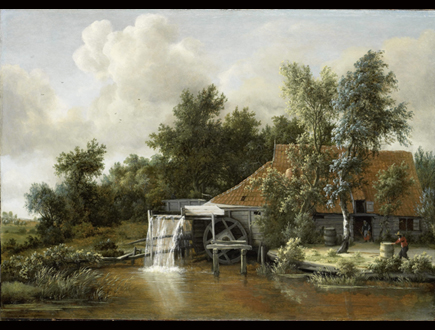
You might wonder why I haven’t chosen a painting by Rembrandt or Vermeer to illustrate an article about an exhibit entitled The Dutch Golden Age, From Rembrandt to Vermeer, showing at the Pinachothèque de Paris until Feb. 7, 2010. But to do so would be as misleading as that second half of the title of the show itself.
Rembrandt naturally looms large in any study of Dutch art of the golden age that was the 17th century, as well as any other period since then, and we all love to peek in on the goings on in a Vermeer home, but you have to look hard to find their works here.
That’s because this isn’t so much an art show as a history show that uses art to inform its viewers. It’s a didactic show that offers a very good overview of what made 17th-century Holland so golden and how art reflected and contributed to its brilliance. As appealing as many of the hundred some paintings and etchings, mostly on loan from the Rijksmuseum in Amsterdam, may be, few inspire a prolonged or studious stare. And they are too diverse to add up to a single vision of art at the time, except to give a sense that there was a lot going on.
Actually, that “a lot going on” is largely the point. With relative freedom of worship, a wealthy upper class, and a growing middle class looking to decorate their homes with paintings as only aristocrats and religious institutions could elsewhere in Europe, artists were called upon—and called upon themselves—to explore (and specialize in) all kinds of subjects: still lifes, rural life, landscapes, cityscapes, family and individual portraits, religion, and daily life.
Shows at the Pinacothèque, Paris’s premier private museum, tend to rely heavily on the written word to make their point, and that is especially the case in this exhibition where the descriptions at the start of each of the show’s eight sections (in French on the wall, to be joined by text in English around mid-October) are important to understanding and enjoying the works.
Prepared by text, the viewer is then all the more willing to pause before works that serve as excellent illustration of the various angles in which life in 17th-century Holland, both artistic and economic, is examined: 1. the artists and their world, 2. still-lifes and applied arts, 3. the city, 4. the countryside, 5. religious images and objects (Rembrandt’s cameo), 6. the citizens, the regents and the aristocrats within the republic, 7. the republic and the Dutch East Indies, and 8. genre scenes/scenes of daily life (Vermeer’s cameo).
Altogether, The Dutch Golden Age (disregard the second half of the show’s title) is a highly informative show. Forget about Vermeer. And bring your reading glasses.
The Dutch Golden Age, from Rembrandt to Vermeer
Oct. 7, 2009-Feb. 7, 2010
Pinacothèque de Paris, 28 place de la Madeleine, 75008 Paris. Metro: Madeleine. Tel. 01 42 68 02 01. Open daily: Mon., Tues., Thurs., Sat., Sun. 10:30 a.m. to 8 p.m., Wed., Fri. 10:30 a.m. to 10 p.m. Entrance: 10€.
© 2009, Gary Lee Kraut

